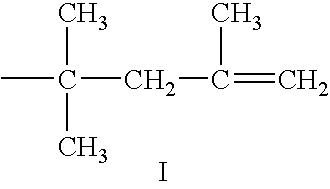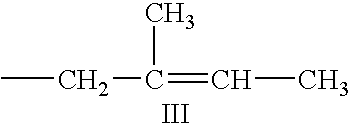Mixed dispersants for lubricants
a technology of lubricant and dispersant, applied in the field of mixing dispersants for lubricants, can solve the problems of increasing the viscosity of lubricant formulations or especially concentrates, severely reducing the anti-wear protection of oil,
- Summary
- Abstract
- Description
- Claims
- Application Information
AI Technical Summary
Benefits of technology
Problems solved by technology
Method used
Image
Examples
examples
Syntheses of chlorine-route hydrocarbyl-substituted Succinic anhydride Preparative Example A
[0071]Conventional polyisobutene, Mn 2000, prepared using AlCl3 catalyst, 3000 g, and maleic anhydride, 101 g, are added to a 4-neck, 5-L round bottom flask equipped with an overhead stirrer, a thermowell with thermocouple, subsurface gas inlet tube, and appropriate condensers and traps. The mixture is heated, with stirring, to 146° C. Chlorine gas (39.5 g) is added over 5 hours while increasing the temperature to 165° C. The mixture is then heated to 182° C. over 2 hours and maintained at 182° C. for 1 hour. Additional chlorine gas (45.7 g) is added over 5 hours, while increasing the temperature to 193° C. The mixture is further heated to 196° C. and maintained for 5 hours and thereafter at 215° C. for 25 hours with a subsurface nitrogen purge.
Syntheses of non-chlorine hydrocarbyl-substituted Succinic anhydrides Preparative Example B
[0072]To a 4-neck 1 L flask equipped substantially as in Pr...
example c
Preparative Example C
[0073]Preparative Example B is substantially repeated except that 500 g of 2000 Mn high vinylidene polyisobutylene and 68 g of maleic anhydride are employed. The product contains 30% oil.
Synthesis of Dispersants Preparative Example D
[0074]To a 4-neck, 1 L round bottom flask equipped with overhead stirrer, thermowell with thermocouple, Dean-Stark trap with condenser, and an equal-pressure addition funnel with subsurface inlet, are charged 300 g of a product prepared as in Example A and 253 g mineral oil. The mixture is heated, with stirring, to 110° C. and nitrogen flow is begun at 2.8 L / h (0.1 ft3 / hr). Polyethyleneamine bottoms (available form Dow as HPA-X™), 14 g, are added to the reaction mixture over 0.5 hour and the mixture is maintained at 110° C. for 0.5 hour after addition is complete. The mixture is heated to 155° C. and held for 5 hours with nitrogen flow. Filter aid is added to the mixture, which is filtered to yield the dispersant product in oil.
example e
Preparative Example E
[0075]A similar dispersant is prepared from the material of Preparative Example B.
PUM
| Property | Measurement | Unit |
|---|---|---|
| weight percent | aaaaa | aaaaa |
| weight percent | aaaaa | aaaaa |
| weight percent | aaaaa | aaaaa |
Abstract
Description
Claims
Application Information
 Login to View More
Login to View More - R&D
- Intellectual Property
- Life Sciences
- Materials
- Tech Scout
- Unparalleled Data Quality
- Higher Quality Content
- 60% Fewer Hallucinations
Browse by: Latest US Patents, China's latest patents, Technical Efficacy Thesaurus, Application Domain, Technology Topic, Popular Technical Reports.
© 2025 PatSnap. All rights reserved.Legal|Privacy policy|Modern Slavery Act Transparency Statement|Sitemap|About US| Contact US: help@patsnap.com



